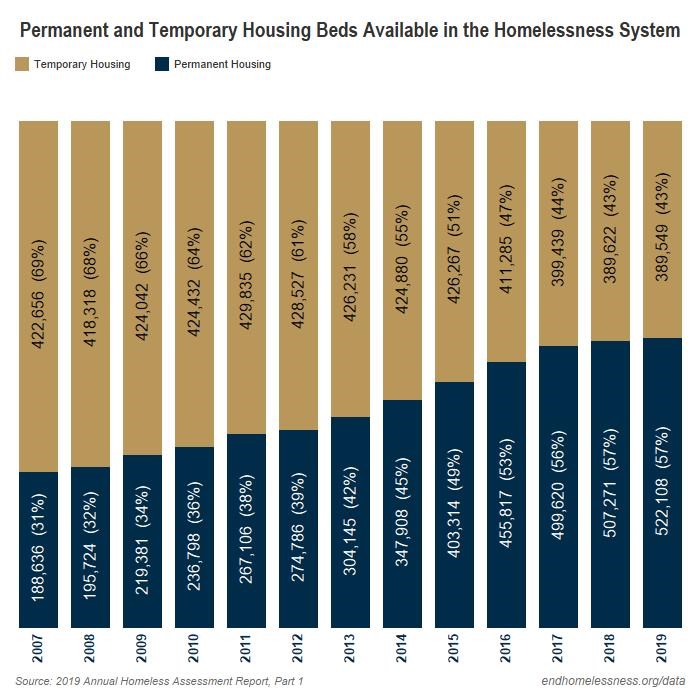Communities across the country are working to permanently end homelessness: analysis from the State of Homelessness: 2020 Edition highlights growing investments in permanent housing. Not only does this policy direction reduce housing instability, but it promotes health and justice.
Increasing Investments in Permanent Housing
The emphasis of homeless systems has progressed from a temporary approach to one that focuses on permanent housing. Since HUD data collection on homelessness began in 2007, the number of permanent housing beds in the system increased by 177 percent. In 2007, permanent housing comprised 31 percent of the national inventory. The most recent data, from 2019, shows that permanent housing now makes up 57 percent.
All but one state grew their permanent housing stock since 2007. Some states stand out for their increased investments. Mississippi shows the largest addition of permanent housing to their inventory with 621 percent more beds than their prior twelve years. Other places with notable increases in permanent housing include Hawaii, Oklahoma, and Guam—each showing a more than 400 percent jump in their inventories. Arkansas has lost 3 percent of its permanent housing inventory since 2007.

Permanent Housing Ends Homelessness
Studies over the last twenty years have repeatedly shown that housing, provided with a Housing First approach, ends homelessness, and that the overwhelming majority of people who receive this intervention stay housed. In fact, more than 50 researchers outlined the evidence in support of Housing First in a letter to the current administration.
Many permanent housing beds in the nation’s homeless services inventory are targeted to specific subpopulations. Forty-four percent are dedicated to people in families, 22 percent are for veterans, and 35 percent are for those who are chronically homelessness (there is some overlap among these populations). These groups have all seen reductions in the number of people experiencing homelessness, supporting the notion that investments in permanent housing reduce homelessness.
Unfortunately, the largest portion of the homeless population – individual, non-disabled adults – are not realizing these same reductions. There have not been as many resources available to them, and we are seeing their numbers increase. Communities should periodically review their bed inventory with such concerns in mind.
Permanent Housing is Healthcare
Now, more than ever, permanent housing is critical because it will help reduce the spread of COVID-19 among people experiencing homelessness and the larger community. Social distancing in congregate shelter is extraordinarily difficult. Access to running water for those who living outdoors is even more of a challenge. Permanently housing people now will not only help quell the risks for the virus spreading, but it will also lower the chance of people dying from it. In a recent Alliance survey of Continuums of Care, 56 percent indicated that permanent housing is a more of a future spending priority than options like additional shelter or motel space.
Housing has always been part of adequate healthcare. Multiple studies demonstrate the impact housing has on improving the health of someone experiencing homelessness. Not only do people self-report being in better health after being housed, their healthcare costs to the system decrease as well. Moreover, it is important to recognize that homelessness itself can create enormous physical and mental health challenges. According to a report by the National Healthcare for the Homeless Council, “Homeless people suffer all illnesses at three to six times the rates experienced by others, have higher death rates, and have dramatically lower life expectancy.”
Permanent Housing is Justice
Housing First approaches get people into housing quickly, without preconditions such as sobriety or employment, and wraps supports around them to provide as much or as little case management services as necessary to help their housing stability. Everyone deserves housing, including people experiencing homelessness. Full stop. No one should have to prove their worthiness in order to have a place to sleep at night, eat, and wash. Housing First is housing justice.
Conclusion
Permanent housing solves homelessness. While the system still struggles to meet housing needs of every person experiencing homelessness, the ongoing commitment to permanent housing is a promising sign. The investments made to help specific groups (families, veterans, and chronically homeless people) demonstrate that with adequate resources, reducing, and even ending homelessness is possible.

